Narcisse Berchère: A French Painter's Journey Through the Orient
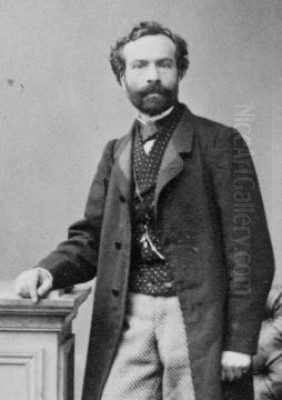
Narcisse Berchère (1819–1891) stands as a significant figure within the French Orientalist movement of the 19th century. A dedicated painter, Berchère carved a niche for himself by focusing primarily on the landscapes, architecture, and atmospheric conditions of Egypt and North Africa. His life and work reflect the deep fascination that the "Orient" held for European artists and audiences during this period, offering a window into distant lands rendered with meticulous detail and a keen sensitivity to light and place. Born in Étampes, France, his career spanned a dynamic era in art, witnessing the interplay of Romanticism, Realism, and the burgeoning interest in ethnographic and scenic depiction.
Early Life and Artistic Formation
Born Narcisse Berchère on September 11, 1819, in the town of Étampes, located in the former Seine-et-Oise department of France, his artistic inclinations emerged early. While the provided information mentions his education was provided by "Remond," this likely refers to Jean-Charles-Joseph Rémond (1795–1875), a respected landscape painter known for his historical landscapes and his adherence to neoclassical principles, albeit with a sensitivity to natural effects. Studying under a master like Rémond would have provided Berchère with a solid foundation in drawing, composition, and the techniques of oil painting, particularly within the landscape tradition.
This period in French art was vibrant; the influence of Romanticism, championed by artists like Eugène Delacroix (1798–1863), was still palpable, especially in the choice of exotic subjects and dramatic presentation. Simultaneously, the Barbizon School painters, such as Camille Corot (1796–1875) and Théodore Rousseau (1812–1867), were revolutionizing landscape painting by emphasizing direct observation from nature. Berchère entered this artistic milieu equipped with traditional training but poised to engage with the contemporary fascination for lands beyond Europe.
The Call of the East: Travels and Inspiration
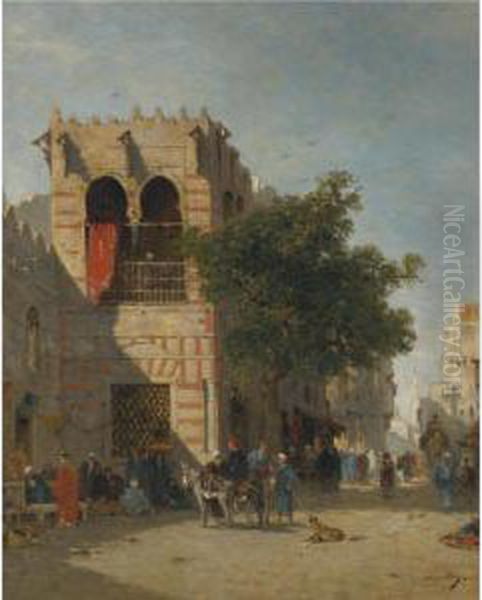
The trajectory of Berchère's career was decisively shaped by his travels to the Middle East. His first significant journey took place in 1849-1850 when he visited Egypt. This initial encounter with the landscapes, ancient monuments, and vibrant street life of the region left an indelible mark on his artistic vision. The unique quality of light, the vastness of the desert, and the distinct architectural forms provided a wealth of new subject matter, far removed from the familiar scenery of France.
A second crucial trip occurred in 1856, during which Berchère explored Egypt and the Sinai Peninsula more extensively. Significantly, he traveled in the company of fellow artists, including the sculptor Frédéric Auguste Bartholdi (1834–1904), who would later gain international fame as the creator of the Statue of Liberty. Traveling with peers likely fostered a stimulating environment for artistic exchange and observation. This journey further solidified Berchère's commitment to Orientalist themes, allowing him to gather sketches, studies, and impressions that would fuel his paintings for years to come.
These expeditions placed Berchère among a growing number of European artists venturing eastward. Painters like Alexandre-Gabriel Decamps (1803–1860) and Prosper Marilhat (1811–1847) had already established reputations based on their Eastern subjects earlier in the century. Berchère built upon this tradition, contributing his own distinct perspective, often characterized by a calmer, more topographical approach compared to the dramatic intensity found in some of Delacroix's North African scenes.
Artistic Style and Themes
Narcisse Berchère is primarily recognized as an Orientalist landscape painter. His works predominantly feature scenes from Egypt and North Africa, focusing on the interplay between the natural environment and human presence. Unlike some contemporaries, such as Jean-Léon Gérôme (1824–1904), who often populated their canvases with detailed historical or genre scenes, Berchère frequently gave precedence to the landscape itself. His paintings depict desert expanses, oases, the banks of the Nile, ancient ruins, and the bustling streets or quiet corners of cities like Cairo.
His style is characterized by careful observation and a high degree of finish. He paid close attention to architectural details, the textures of sand and stone, and the specific flora of the regions he depicted. A key element in his work is the rendering of light and atmosphere. Berchère skillfully captured the intense sunlight of the desert, the hazy heat of the afternoons, and the long shadows cast at dawn or dusk. His palette often employed warm earth tones – ochres, browns, and reds – contrasted with the vibrant blues of the sky or the deep greens of sparse vegetation, effectively conveying the climate and mood of the locations.
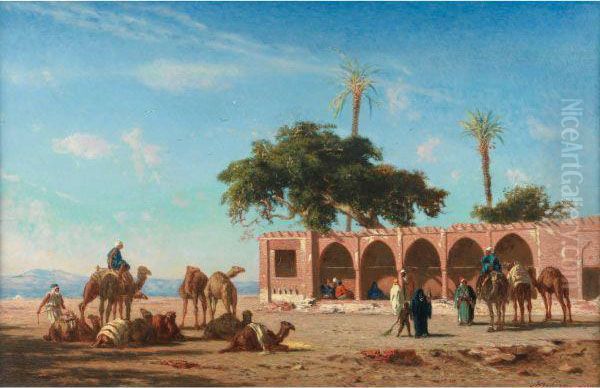
While grounded in observation, his work is not merely documentary. It embodies the 19th-century European romanticization of the East, presenting scenes that evoked a sense of timelessness, exoticism, and sometimes melancholy beauty. His compositions are typically well-balanced, often using strong horizontal lines of the desert or river, punctuated by vertical elements like palm trees, minarets, or figures. The human figures in his paintings, though often present, tend to be integrated into the landscape rather than being the primary focus, serving to indicate scale and local life.
Representative Works
Berchère's oeuvre includes numerous paintings that exemplify his style and thematic concerns. Several works are repeatedly mentioned and appear in auction records, indicating their recognition as characteristic pieces:
Campement au bord de l'oasis (Camp at the Edge of the Oasis) or similar titles like Village at the Entrance to the Desert: This subject appears frequently, depicting Bedouin tents or small settlements nestled near a source of water and vegetation, contrasting the harshness of the desert with the refuge of the oasis. These works showcase his ability to render the textures of tents, the sparse landscape, and the atmospheric light. Auction records from Drouot confirm the market presence of such scenes.
Sakieh sur les bords du Nil (Sakieh on the Banks of the Nile): This painting, likely from around 1865, depicts a traditional Egyptian water wheel (sakieh) used for irrigation. It highlights Berchère's interest in the daily life and traditional technologies of Egypt, set against the backdrop of the vital Nile River. It combines landscape elements with a focus on human activity integral to the region.
A Busy Street, Cairo or Le Caire: These works capture the urban environment, contrasting with his desert scenes. They likely depict the narrow, crowded streets of historic Cairo, featuring characteristic Islamic architecture, bustling crowds, and market activities. Such paintings allowed Berchère to explore complex compositions and the interplay of light and shadow in an urban setting.
Le Repos de la caravane (The Rest of the Caravan): A classic Orientalist theme, this subject portrays a caravan of camels and travelers pausing during their journey across the desert. It evokes the romance and hardship of desert travel, a popular motif for European audiences fascinated by the perceived adventures of the East.
Le village sous l'ombralisation des ruines égyptiennes (The Village in the Shadow of Egyptian Ruins): This title suggests a composition juxtaposing contemporary village life with the imposing presence of ancient monuments, a theme explored by many artists visiting Egypt, including the British painter David Roberts (1796–1864). It speaks to the layers of history embedded in the Egyptian landscape.
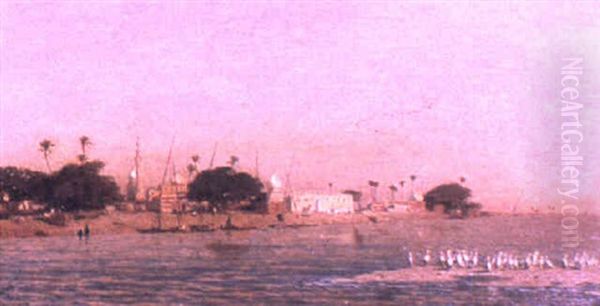
Medina Gate or Entrance to Cairo: These titles point to works focusing on architectural elements, specifically the impressive gateways common in North African and Middle Eastern cities, serving as focal points and symbols of passage between different spaces (e.g., desert and city, outside and inside).
These works, typically executed in oil on canvas or panel, demonstrate Berchère's consistent engagement with Orientalist subjects, rendered with his characteristic attention to detail and atmospheric effect.
The Suez Canal Connection
A unique and significant episode in Narcisse Berchère's career was his involvement with the Suez Canal project. In 1860, he was personally selected by Ferdinand de Lesseps (1805–1894), the driving force behind the canal's construction, to serve as an official draftsman and painter for the Suez Canal Company (Compagnie Universelle du Canal Maritime de Suez). This prestigious appointment tasked Berchère with documenting the monumental engineering feat as it unfolded.
His role involved creating visual records of the construction process, the landscape being transformed, and the various sites along the canal's route. These works served not only as documentation but also likely played a role in promoting the ambitious project to the public and investors in Europe. This connection provided Berchère with unparalleled access to the region and a specific focus for his artistic endeavors during this period.
Berchère was present for the lavish inauguration ceremonies of the Suez Canal in November 1869, an event attended by international dignitaries, including Empress Eugénie of France. For this occasion, he traveled to Egypt once again, reportedly in the company of other prominent French artists, notably the highly acclaimed Orientalist painter Jean-Léon Gérôme and the painter and writer Eugène Fromentin (1820–1876). Witnessing and documenting this historic event marked a high point in Berchère's career, linking his art directly to one of the great technological and geopolitical achievements of the 19th century.
Exhibitions and Recognition
Throughout his career, Narcisse Berchère regularly exhibited his paintings at the official Paris Salon, the most important venue for artists seeking recognition and patronage in France. His consistent participation indicates his active engagement with the Parisian art world and his desire to reach a wide audience. His Orientalist landscapes were generally well-received, catering to the public's taste for exotic subjects rendered with technical proficiency.
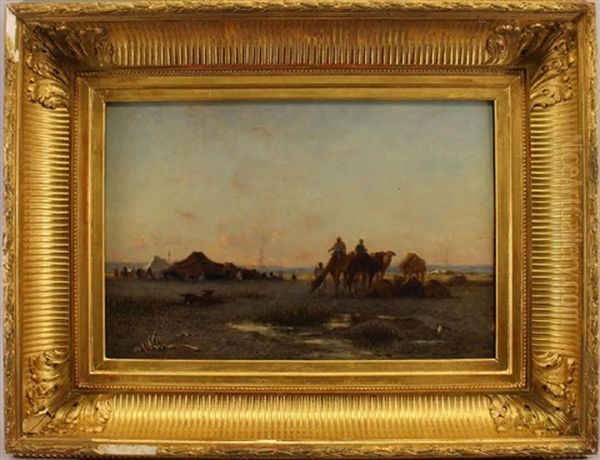
While perhaps not achieving the same level of fame as Gérôme or Delacroix, Berchère established a solid reputation as a specialist in Orientalist landscapes. His works were acquired by collectors during his lifetime, and they continue to appear on the art market today, as evidenced by auction records from houses like Drouot in Paris. The prices his works command reflect a continued appreciation for his skill and his contribution to the Orientalist genre. His paintings are held in various public and private collections, particularly in France.
His inclusion in academic studies and online art resources like WikiGallery.org further attests to his recognized place within 19th-century French art history. He is acknowledged as a competent and dedicated painter who effectively captured the visual allure of Egypt and North Africa for a European audience.
Contemporaries and Influence
Narcisse Berchère worked during a period rich with artistic talent, both within France and internationally. His career intersected with numerous important figures:
Teacher: Jean-Charles-Joseph Rémond provided his foundational training in landscape.
Travel Companions: His journeys connected him with Frédéric Auguste Bartholdi, Jean-Léon Gérôme, and Eugène Fromentin, all significant artists in their own right.
French Orientalist Peers: He was part of a broader movement that included pioneers like Eugène Delacroix and Alexandre-Gabriel Decamps, as well as contemporaries like Prosper Marilhat, Théodore Chassériau (1819–1856), Gustave Guillaumet (1840–1887), and Léon Belly (1827–1877), each bringing their own interpretation to Eastern subjects.
International Orientalists: The fascination with the East was not limited to France. British artists like John Frederick Lewis (1804–1876) and David Roberts, and the Italian painter Alberto Pasini (1826–1899), were also renowned for their depictions of the Middle East, creating a diverse international tapestry of Orientalist art.
Broader French Context: Berchère's focus on landscape resonates with the work of Barbizon painters like Corot and Rousseau, even if his subject matter differed. His detailed realism can be seen in contrast to the emerging Impressionist movement later in his career, led by artists like Claude Monet (1840–1926) and Edgar Degas (1834–1917), who prioritized capturing fleeting moments and the effects of light in a different manner. His work also stands apart from the provocative Realism of Gustave Courbet (1819–1877).
While Berchère may not have been a radical innovator who dramatically altered the course of art history, he was a skilled practitioner within his chosen genre. His influence lies in his contribution to the visual vocabulary of Orientalism, particularly his emphasis on the atmospheric landscape, and his unique role in documenting the monumental Suez Canal project.
Legacy and Art Historical Assessment
Narcisse Berchère passed away in 1891, leaving behind a substantial body of work dedicated to the landscapes and life of the Orient, primarily Egypt. His legacy is firmly tied to the Orientalist movement, a complex phenomenon reflecting both genuine European curiosity about other cultures and the geopolitical realities of colonialism and imperialism. Berchère's paintings, with their detailed observation and evocative atmosphere, contributed significantly to shaping the European visual imagination of the Middle East in the 19th century.
He is remembered as a specialist, an artist who found his primary inspiration in the sun-drenched lands of North Africa and diligently translated his experiences into meticulously crafted canvases. His focus on landscape distinguishes him somewhat within the Orientalist field, offering a counterpoint to the more narrative or ethnographic focus of some of his contemporaries. The quality of his execution, particularly his handling of light and architectural detail, ensures his work retains artistic merit.
His involvement with the Suez Canal adds a unique historical dimension to his career, positioning him as a visual chronicler of a pivotal moment in modern history. While critical perspectives on Orientalism have evolved, acknowledging its often romanticized or stereotyped portrayals, Berchère's work remains valuable for art historians studying the movement and for audiences interested in 19th-century depictions of the Middle East. He stands as a talented and dedicated French painter whose journeys Eastward resulted in a lasting artistic contribution.